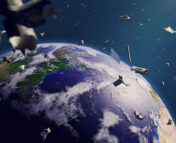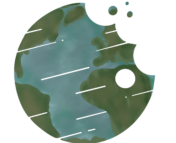Papers featured in this bite:
A Realistic Projection of Climate Change in the Upper Atmosphere Into the 21st Century
Just when we thought it couldn’t get worse, the satellite constellations threatening our night sky and the climate crisis impacting every aspect of our lives have joined forces. It is now established that numerous and largely unregulated swarms of satellites in low Earth orbit (LEO) have a direct impact on ground-based astronomy, as discussed in this Astrobite. Now, researchers have determined that the decreasing density of the upper atmosphere due to climate change is only worsening the space debris issue, increasing the orbital lifetimes of active satellites and space trash alike and creating an environment of debris cloaking the Earth.
Changes in the thermosphere
The effects of climate change extend beyond the surface of the Earth out to all levels of the atmosphere. A few teams set out to understand the consequences of climate change through a specific lens: how do CO2 emissions impact the upper atmosphere and the space debris environment? In today’s bite, we cover two papers that independently model global conditions and make projections for the future of the upper atmosphere given a changing climate.
Human-induced climate change leads to a global warming at ground level, but if we move up in the atmosphere by 15-500 km, this same increased concentration of greenhouse gasses causes a global cooling in the middle to upper atmosphere. A decrease in temperature causes this part of the atmosphere to effectively shrink, which in turn reduces the air density in the thermosphere (~90−500 km above the ground). While there are a few variables that impact the density of the thermosphere, increasing CO2 concentration at the ground plays a main role in global cooling and contraction of the upper atmosphere.
The thermosphere is home to thousands of LEO satellites, including the International Space Station, and while it hosts satellites, it also naturally pulls them back down to Earth over time. But the rate at which the atmosphere sends satellites back down to the ground is affected when the density of the atmosphere changes – the question is, by how much?
BRAD and other models
The teams validate and then project models of global circulation into the future to make predictions for the state of the thermosphere out multiple decades. Both studies find similar projections of climate change in the upper atmosphere, with Cnossen (2022) predicting a global mean cooling and a decline in thermosphere density for 2015–2070 that is about twice as strong as that of the past.
In Brown et al. (2021), the authors use a method called BRAD, or the Binned Representative Atmospheric Decay debris model. BRAD essentially makes a few clever assumptions to handle the motions and collisions of objects in LEO statistically, working to distill a pretty messy system and figure out how the objects in LEO will decay in their orbits when the density changes. Given a global temperature increase of 1.5ºC, Brown et al. predict a 15-32% decrease from the year 2000 to now in the thermospheric density at 400 km, a reduction that will speed up with any further increases to CO2 concentration. While BRAD inherently doesn’t model effects of large constellations of satellites, their results imply that the thermospheric density will greatly impact lone and constellations of satellites alike, at least doubling (and possibly increasing by 10-20x) the number of trackable objects (meaning both active instruments and the trash left behind).
An atmospheric drag
Why exactly does climate change in the upper atmosphere lead to a doubling of trackable objects in LEO? With density decreased, atmospheric drag is reduced, so orbital lifetimes of satellites increase: reducing atmospheric drag makes it easier for satellites to whiz around the Earth. With easier travels, they can live in their orbits longer, and lead to the accumulation of space debris. For example, Cnossen (2022) find that a decrease in thermospheric density of ~30% maps to an increase in orbital lifetimes by ~30% as well.
Increased space debris poses risk to other spacecraft, which is relevant to – as Cnossen (2022) put it – the “future exploitation” of the LEO environment. Objects that remain in orbit longer are given more chances to collide with other debris or active satellites. Fragmented space debris can quickly trigger a cascade of more collisions, as by introducing more objects in orbit, the potential for two objects to hit each other rises dramatically. From there, the fragments from such an impact increases the number of objects in LEO, and increases the probability of more collisions. This scenario, called the Kessler Syndrome, could mean trouble for future space activities, and in an extreme case space activities could even be made impossible for decades. And, beyond the potential collisions and resulting trash cloud, staying in orbit longer also impacts long-term effectiveness of satellite-based measurements that need to be stable like precise measurements of sea level.
This vicious cycle of satellite population growth worsening climate change, which in turn negatively impacts the satellite debris environment is well-established and exemplifies how our human impacts on Earth are not limited to the ground. Faced with the reality of climate change advancing and satellite megaconstellations continuing to be launched, this Astrobite lists ways to help preserve the global commons that is our night sky. Space trash doesn’t have to be a permanent fixture of our night skies, but we do have to take significant steps in taking satellites down, which primarily depends on action from the two companies (SpaceX and OneWeb) that own nearly half of all LEO satellites. With the satellite population booming and catastrophic collisions becoming more and more common, we may have already reached a point of instability in terms of space trash, and action to mitigate both climate change and satellite overpopulation is more and more critical.
This article was written as a part of our Climate Change Series. We’d love to hear what you would like to see from this initiative – if you have ideas, please let us know in this google form.
Disclaimer: This article was written and edited by a group of Astrobites authors. It is not intended to be representative of the views of the AAS (which supports Astrobites) or all astronomers.
Astrobite edited by Catherine Manea
Featured image credit: European Space Agency/ID&Sense;/ONiRiXEL ,CC BY-SA 3.0 IGO




